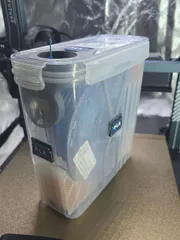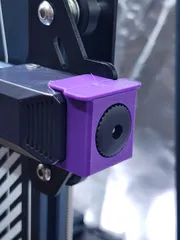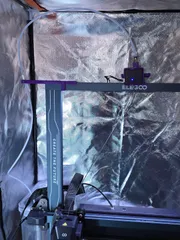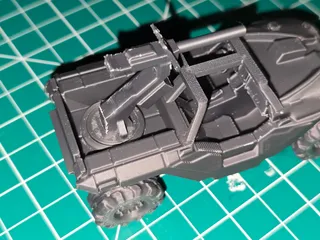Modular Magneto Micrometer
Description
PDFA tool I created to be able to measure the various magnets I'm starting to incorporate in my prints. Some are N52, while others of the same size are probably N48 so I wanted to be able to figure out the difference, and also to decide which size of magnets I might need for various use cases.
I was inspired by seeing a simple 3d printed device by u/Fioricascastle over on Reddit using the Bambu Labs module a few weeks back, while I was in the middle of having used a travel luggage scale to compare magnet holding power (really, really rough). I realized what I might be able to do, and once I finally finished it was able to differentiate the magnets that the simple measurement was fuzzy on. The big inspiration was becoming aware of that module.
Hardware Needed
Non-printed hardware needed are as follows
- 1 Bambu Labs “Y Shape LED Light with Magnetic Control Switch”
- 1 M3 cap head screw 12mm or longer
- 2 M3 nuts
Downloading/slicing
To build, choose which size you need (I have ones that move 10mm, 25mm, and 50mm). For the track the difference between the 10mm and 25mm ones is minimal so using the 25mm track is OK.
Aside from the main .stl versions, I have also uploaded step file versions as those normally are much smaller, and give me better results in OrcaSlicer.
Common parts
For all versions you will need
- Anvil10x5.stl
- Arm.stl
- either ClipB2.stl
or ClipB.stl - CouplerB.stl
- Either Knob.stl
or KnurledKnob.stl - RetainingClip.stl
- SledLock.stl
- Sled.stl
Specific parts
Then for the version you want you will need
- HubXX.stl
- SpindleXX.stl
- ThimbleXX.stl
- TrackXX.stl (although the larger tracks will work for smaller sizes)
Be sure that the hub, spindle and thimble all match.
Printing
Each piece should be printed in the orientation that they come in.
When printing the anvil or coupler be sure to add at least a 1 layer raft. (They are angled to give sufficient strength)
Testing
Before committing to printing the main parts, it's best to test your settings to ensure the threads will behave properly, etc. The design was done by measuring printed parts to match the CAD sizes, and additionally verifying the threaded pieces against standard metal nuts and bolts. If your printer is dialed in with sufficient accuracy there should be minimal tuning needed.
As a first step, print ScrewTestF.stl and SledLock.stl. They should screw together with not too much force, especially after the first time through. When testing most any common coin could be used, or I've included a couple of sample wrenches (which I made so that I did not have to go out to my garage to get my actual toolbox.)
Once the print settings are getting nice results that can be screwed all the way through each other, it is safe to proceed with the main parts.
Assembling
Pictures coming soon… for now I have extra detailed text.
- take the M3 screw and put it into the top of the knob (or knurled knob).
- fit an M3 nut onto the end and tighten it up with an Allen wrench as tight as it will go.
- drop the other M3 nut down the opening at the small end of the spindle until it rests flat against the bottom where the threads are.
If you are having trouble getting it flat you can use a thin screwdriver to push the nut in level, or use something like a spare length of PTFE tubing to push and get it seated. - holding the spindle with the threads and nut down, slide the thimble up against it.
- hold the knob and push the end of the M3 screw into the hole in the thimble and twist until it catches the nut inside the spindle. )If you gently let the knob down it will be held by the nut once it has started).
- tighten the M3 screw by turning the knob, but only until you hit up against the thimble, leaving things free to turn a little for now.
- push the thin end of the spindle into the threaded end of the hub, and then start turning and tightening it. Tighten it just to finger tightness by holding the thin end of the spindle and in one hand and the hub in the other (most will end up covered by the thimble, but there should be just enough to grip).
- when the spindle is in the hub as far as it will go, rotate the thimble until the lines on both align.
- holding the extending part of the spindle and the thimble in one hand to keep them together, use the other hand to tighten the knob.
- turn the spindle, thimble, and knob as one to loosen from the hub. Don't worry about being too precise, as the key is to just have a common starting point that measurements will be relative to.
- insert the thin end of the spindle followed by the end of the hub with the notches into the arm. Push carefully but strongly until it seats.
- push the retaining clip in to the slot in the arm & hub, being sure to align the slanted edge correctly. Push until both ends click into place
- push the arm firmly all the way into the square hole in the track's raised part.
- screw the coupler into the end of the spindle
- gently press the LED module into the coupler, being sure to align the magnetic sensor above the axis of the shaft of the spindle. On mine the sensor chip is labled U1 and is the one next to a flat edge of the PCB.
- slide the sled into the end of the track
- fit the sled stop into the sled and screw it in until the pressure almost stops the sled from sliding.
- carefully fit the “anvil” down into the top of the sled, with the ledge facing away from the sensor module.
- using the thimble and module, screw the sensor all the way as far as it will go.
- slide the sled until it is just touching the sensor module, or almost.
- tighten down the sled stop to prevent the sled from moving.
The device should now be ready to use.
Usage
- Turn to loosen until the sensor is far enough from the sled. For smaller magnets I only need 15-20 mm clearance.
- place the magnet in the back of the anvil and secure with a clip.
- turn the knob and/or thimble to bring the sensor close to the magnet. Try to slow down when you get close to activation range.
- as soon as the LEDs change, pause and check the distance measured.
- back up 5mm+ and then move slowly forwards again. Each change of the lights (on, fast blinking, slow blinking, off) should happen as you cross into the triggering distance.
- you should now have the activation distance for the measured magnet.
Tags
Model origin
The author marked this model as their own original creation.




